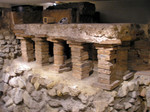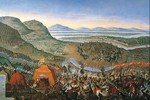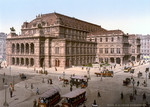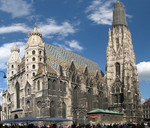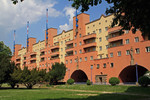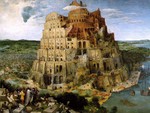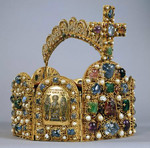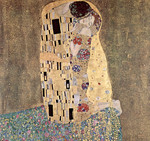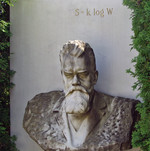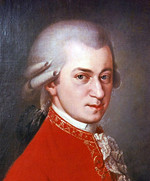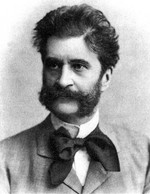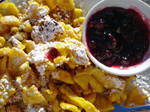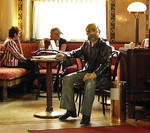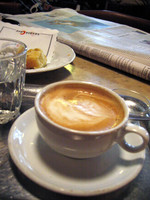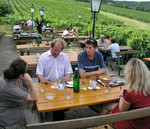Vienna Art & Culture
Vienna is quite rich in culture, and consequently this page is rather long. It gives an overview of what to see and do in Vienna. Naturally, you can find much more information on the web (e.g. Wikipedia) and in guide books.
History
The city of Vienna was essentially founded by the ancient Romans, who erected several military camps along the river Danube, which was then the border of their empire. One of them, called Vindobona, lies beneath the modern city center and you can actually visit Roman excavations today.
The city's importance grew rapidly with the rise of the Habsburg empire, who made it their residence in the late middle ages. In 1529 and 1683, Vienna was sieged by Ottoman armies, but they failed to conquer the city in both cases.
In the early 19th century, the Holy Roman Empire was dissolved and Vienna became the capital of the newly founded Austrian Empire (which later turned into the Austro-Hungarian Monarchy), still under the rule of the Habsburg dynasty. In the late 19th century, Vienna became a truly cosmopolitan city with a population exceeding 2 million - more than today. Impressive buildings were erected then, many of which can still be seen today.
Pride goes before a fall, and thus the first half of the 20th century was certainly not the best time in history: WW1, which brought the end of the monarchy, a considerable reduction in the size of Austria and a premature democracy, followed by fascism and WW2. After that, Vienna was somewhere between east and west for a few decades. Eventually, Austria has re-established her international reputation, and Vienna has regained the status of a cosmopolitan city in central Europe.
Even though nowadays Vienna is a modern city such as many others, you can still see and feel the heritage of the Habsburg monarchy in many places (which is, admittedly, often touristily exploited). But when you take a closer look aside of well-trodden visitor's paths, you can also spot the more recent history which sometimes appears to be closer to eastern Europe than the West.
Architecture
Many sights are located in or around the present city center, as this was the entire city for many centuries, strictly confined by a fortification. Only few romanesque and gothic buildings remain, which are typically churches. The most famous one is certainly St. Stephen's Cathedral, which marks the very center of Vienna and features both medieval architectural styles. The imperial Hofburg Palace also has a medieval core, but was extended and modified many times in various kinds of styles, such that the original look is well concealed today.
The baroque style is much more prominent in Vienna (and Austria). Many churches were built in that period, among them St. Charles's Church, which is located in close proximity to the conference venue. But there are also important secular buildings from the baroque era, most prominently Schönbrunn and Belvedere palaces. Also the former university building which now hosts the Austrian Academy of Sciences (where we will attend the Classical Concert) stems from that period.
The predominant historic style, however, dates back to the latter half of the 19th century, and is generally known as historicism. It means that previous styles were copied and often combined. As in many other cities, the fortification was eventually torn down, making room for a circular boulevard around the city center with many important buildings, such as the City Hall, the State Opera, the Parliament and several others. The architectural style was often chosen according to the function of the building. Ancient Greece, as an example, was considered the birthplace of democracy, and hence the parliament building was erected in a neo-classical style. Moreover, many residential buildings in place today date back to the turning of the (19th to 20th) century.
Around 1900, the Jugendstil (Art noveau) emerged, and there are still several remnants of that era, most notably the Vienna Secession building, which is not far from the conference venue. The first metropolitan railways, built by Otto Wagner, also date back to that era, and you can still see the historic Karlsplatz station building close to the venue. Soon thereafter, modernism emerged, which was widely applied in an unparalleled municipal tenement building program between WW1 and WW2. One of the most prominent architectural evidence of that era is the Karl-Marx-Hof with more than 1300 apartments. It is more than a kilometer long and remains the longest residential building in the world to date.
Even though Vienna is largely bound to (art) history, also modern buildings can be found throughout the city. One important example is the Vienna International Centre, which hosts the United Nations office at Vienna and dates back to the 1970s. Typical specimen of 1980s postmodern architecture are the Marriott hotel opposite Stadtpark along the circular boulevard around the city center or the Haas-Haus right opposite of St. Stephen's Cathedral in the city center. A completely different style, although from the same period, can be found in the tenement building by Hundertwasser. In the third millenium, even deconstructivism entered Vienna, such as with the T-Center. Moreover, a few clusters with skyscrapers emerged recently in outer districts. Nonetheless, it is unlikely that Vienna will one day be known by its skyline.
Museums
Vienna has a long tradition of arts, and consequently a large number of museums. The collections on display range from traditional paintings to very specialized topics such as globes, schnapps or undertakers.
During their long reign, the Habsburg dynasty collected numerous works by artists such as Raphael, Caravaggio, Tizian, Rubens, Bruegel, Arcimboldo and many others. Those paintings, as well as artefacts from ancient civilizations, are on display in the Kunsthistorisches Museum. Speaking of Habsburg: The crown jewels of the Holy Roman Empire and the Austrian Empire as well as many other valuables can be seen in the Secular and Ecclesiastical Treasury.
Paintings of the 19th and early 20th centuries, most notably Klimt, Schiele and Kokoschka, are hosted in the Upper Belvedere. Similarly, the Leopold Museumis focused on paintings of the early 20th century. It is located in the so called Museumsquartier, a complex which houses several museums, but also bars and restaurants. An impressive collection of drawings (e.g. by Dürer) and prints can be found in the Albertina.
The history of Vienna is well represented in the Wien Museum, next to St. Charles's Church not far from the conference venue. MAK, the museum of applied arts, has a large collection of handicrafts from medieval to contemporary periods. The Sigmund Freud Museum is located in the former place where the inventor of psychoanalysis lived and worked. The rich Jewish history of Vienna is revealed in the Jewish Museum Vienna.
This is only a short list of the most prominent museums. If you want to go into more detail and maybe really want to visit the schnapps museum (yes, there is such a thing!), please refer to this comprehensive list of museums in Vienna.
Even though it is not exactly a museum, Vienna's central cemetary is certainly worth a visit. It is located half way towards the airport (S-Bahn station Zentralfriedhof) and has a (dead) population of almost twice the present (alive) city of Vienna. Famous people are buried in the VIP section which has a Jugendstil church and graves for all the federal presidents of Austria since 1945 and most of the federal chancellors. Moreover, the VIP section covers the graves of Beethoven, Boltzmann, Brahms, Hansen, Hoffmann, Ligeti, Loos, Marcus, Salieri, Schmidt, Schönberg, Schubert, Strauss, Zawinul and many others. The cemetary also has jewish, buddhistic, protestant, islamic and orthodox sections.
Another cemetary of interest is in Sankt Marx. It was not used anymore after 1874 and preserved since then. Mozart was buried there, and a memorial can be visited, even though the exact location of his grave is unknown, because he was poor then and buried in an anonymous mass grave.
Music
What would Vienna be without music? The Wiener Klassik (First Viennese School)features the most famous composers of the late 18th century: Haydn, Mozart and Beethoven. None of them was born in Vienna, but they all moved to the city, worked and died here. Needless to say that there are many opportunities to listen to their works.
But also in the 19th century, especially the second half, several famous musicians emerged in Vienna, e.g. Brahms, Mahler or the Strauss family. The An der schönen blauen Donau (Blue Danube) waltz by Johann Strauss the younger is probably the best known musical score of the time and has been used in many movies such as Kubrick's 2001.
At the beginning of the 20th century, Vienna was a blooming center of arts, and that of course included music. The Second Viennese School formed around Schönberg who developed the twelve-tone technique, a radically different style compared to the romantic era of the 19th century.
Based on that long tradition, there are many places in Vienna where one can listen to classical music (in a wider sense, including the 19th and early 20th centuries as well). First of all, the well-known Vienna State Opera is certainly worth a visit, but be aware that it is not always easy to obtain tickets. For those who don't care to stand during the performance and queue for one hour or more to obtain tickets, that could be a very cheap and short-term solution, as those tickets are not sold in advance, but only right before the performance. There are two more opera houses in the city: one is the so called Theater an der Wien, quite close to the conference venue and performing rather rare but high-quality works, and the other one is the Volksoper (People's Opera), which also features operettas and musicals. Other places where can see modern musicals are Raimundtheaterand Ronacher.
There are many more places to go if you want listen to a concert. The most prominent one, Musikverein, is the home of the Vienna Philharmonic Orchestra, the venue of their world-famous New Year's Concert, and located on Karlsplatz close to the VCI conference site. In contrast to the traditional program of the Musikverein, the Konzerthaus, which is also close to the conference venue, features a wider range of works, also including contemporary music. In addition to those houses, many more concerts with all kinds of cast - from soloists to full orchestras - are offered every day, e.g. in churches.
In order to give you an example of Viennese music, we have arranged a Classical Concert (in a wider sense) for the participants of the VCI conference, which will take place in the ceremonial hall of the Academy of Sciences.
Eat & Drink
A Beislis a typical, small pub which serves traditional Viennese food at moderate prices, which does not mean it must be of poor quality. Such places can be found in many locations, and they often have a significant fraction of regular guests from the neighborhood.
If you want to try Viennese cuisine, probably the most famous dish is Wiener Schnitzel, originally a veal cutlet enveloped in crispy breadcrumbs, but nowadays mostly offered from pork or chicken (which are cheaper). Other typical foods are Tafelspitz, a delicately boiled cut of beef; Rostbraten, the Viennese equivalent of entrecôte and goulash, which the Viennese borrowed from Hungary (which was then part of the Habsburg empire). As you can already guess, vegetarianism wasn't invented in Vienna. Nonetheless, even people who don't eat meat can enjoy typical Viennese desserts: Kaiserschmarrn (follow the link for a description) or Palatschinken, thin pancakes filled with jam.
The Viennese Kaffeehaus (coffeehouse) is more than just a place where to have a quick coffee. In fact, it can be considered as a kind of public living room where one sits over a single cup of coffee for many hours, reading newspapers or books. There are many traditional coffehouses in the inner city, and already in the early 20th century, those were the focal points of intellectual life in the city. Peter Altenberg, a famous writer and poet of that time, named the Café Central when asked for his residence, and had his mail delivered there. It is located in the ground floor of Palais Ferstel, where we will have the Conference Dinner. Even today, Altenberg can still be seen sitting there - as a statue.
You will encounter many traditional coffeehouses when strolling through the city, and one can be found in proximity of the conference venue: Café Museum, which is located at the northwest corner of Karlsplatz. Its original interior decoration had been designed by Adolf Loos, but is unfortunately lost. Among many others, the painters Klimt, Kokoschka and Schiele were regulars there.
Even though you will most likely succeed ordering just "a coffee", Viennese tradition has developed a large variety of that drink, depending on how it is prepared. Don't worry if you can't keep terms like Mokka, Verlängerter, Melange, Einspänner, Kleiner Brauner apart - many Viennese people can't either. All of those are merely composed of five ingredients at most: coffee, water, milk, sugar and cream. A glass of plain water is always served with the coffee.
Typically, coffeehouses also offer a selection of food, snacks, and - most notably - various kinds of desserts. Pastries that go well with coffee are Apfelstrudel(filled with grated apples) or Topfenstrudel(filled with sweet cheese), the latter often being served with vanilla sauce.
Another typical institution in Vienna and surroundings is the Heuriger, a kind of tavern where wine-farmers sell their own products. The name Heuriger literally means "of this year" and tells they serve wine from the most recent harvest. Originally only beverages were sold and you had to bring your own food, but nowadays every Heuriger has a bar where you can fetch some typical farmer food.
A traditional Heuriger does not sell any alcohol which is not self-made; that also means they do not sell beer. However, there are some touristy places, which are rather a restaurant than a Heuriger - Grinzing is such an area which has more tourists than locals. More traditional (and also less expensive) Heurige can be found e.g. in Nussdorf (terminal station of the northbound D tram) or Neustift am Walde (Bus 35A has a stop by that name).


